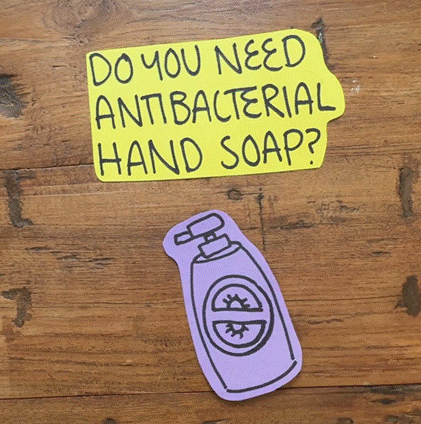December 2024: Hope and Hand Soap
In this edition:
- Healthy Holiday Shopping Guide
- A Toxic-Free Christmas Tree
- New Year, Less PFAS
- PFAS and Neighborhood Disparities
- Calendar
We hope you had a good Thanksgiving holiday. Of course, we must acknowledge that current events have brought a wave of stress and anxiety to many Americans. Our friends and supporters have asked us about whether political changes will undermine our work. The good news is that many of the issues on which we work have had bipartisan support in the past, and many of our current projects involve working with business and state governments to protect our health from harmful chemicals. Onwards and upwards.
Some good news: We are pleased to see increasing evidence that visionary and sound government policies have succeeded in reducing our exposures to harmful chemicals. A new study from the Silent Spring Institute and UC Berkeley looked at data on the
levels of toxic chemicals in blood across our population and concluded that California’s Proposition 65 has curbed exposure to toxic substances. For nearly 40 years this California state law has required manufacturers and retailers to place warning labels on their products containing chemicals that are connected to cancer, developmental and reproductive harm. Many of the chemicals that decreased in people in California and nationwide since their Proposition 65 listing are members of our Six Classes of chemicals of concern including PFAS, bisphenols and phthalates, solvents, and metals.
I am so very privileged to work with the scientists at the Green Science Policy Institute and our outstanding scientist, business, and NGO partners towards further reducing the use of such chemicals.
With regard to stopping the unnecessary overuse of antimicrobials, our message on the harms and lack of benefit of antimicrobial hand soap over plain soap and water has even reached TikTok. In addition to being a popular social media platform, TikTok is now the preferred search engine for many young people aged 15 to 24. Amanda d'Almeida, a medical resident at UCLA who has 1.7 million TikTok followers, many of whom are in healthcare, collaborated with us to make this simple bite-size video – my first experience of TikTok. Please share the 20 second-long video with your networks (of all ages).
Getting out this clear message to consumers, business leaders, and policymakers is critical, as the unnecessary use of harmful antimicrobials is increasing. QACs, commonly used in hand soaps, have been linked to reproductive, respiratory, skin, and neurological harms and may contribute to the global health threat of antimicrobial resistance. Unfortunately, antimicrobials are also used in wipes and laundry disinfectants with no proven everyday benefit. In fact, the Center for Disease Control (CDC) instructs the public to use plain soap and water to wash hands, noting antibacterial soaps “are no better than plain soap at preventing people from getting sick and their ingredients may not be safe for long-term, daily use.”
Similarly, CDC’s guidelines follow what many of our grandmothers told us: regular soap or detergent and water, and perhaps a little bit of elbow grease, is all that is needed to keep our surfaces and clothes safe. Just like antibiotics, antimicrobials should be used with caution and only when necessary. Reducing the unnecessary use of antimicrobials is a priority for us going into 2025.
My own good news: My very personal memoir of scientific and mountaineering challenges, Breaking Trail: A Climbing Life, was just recommended by BookTrib as one of the seven “unforgettable memoirs”. To learn about the origins of the Green Science Policy Institute and my life adventures in the mountains and in reducing harmful chemicals, you can purchase an autographed copy of Breaking Trail on my website, a discounted copy from Amazon, or order from your local independent bookstore.
The BookTrib review concluded: “Her life story is an inspiration not just to those looking to summit mountains, but to all of us who have risks worth taking to pursue what we truly want out of life.”
With best wishes for a happy and healthy holiday season,
Arlene and the Green Science Policy team
P. S. We would like to share our comfortable office in North Berkeley – located near interesting shops, restaurants, and Live Oak Park. Reasonable rent and good neighbors. Contact [email protected] for more information.
Healthy Holiday Shopping Guide
By Rebecca Fuoco
Making your list and checking it twice?

Beware, many popular holiday gift categories can be a minefield for nearly all six classes of harmful chemicals. Here are some online tools for safer shopping:
● Our PFAS-free list includes apparel, shoes, outdoor gear, cosmetics, and more.
● Clearya is a free browser plug-in and mobile app that scans and flags unsafe ingredients for products on Amazon, Sephora, and other online stores.
● EWG’s Skin Deep Database has health ratings for nearly 100,000 personal care products. Their Healthy Living app allows you to scan food and personal care products for health ratings.
● Consider giving your loved ones the gift of a Take Back Bag – a return and recycling service for old clothes combined with rewards. (Note that textiles can take more than 200 years to decompose in landfills!)
Here is some general shopping guidance:
● Check whether products (such as clothing and shoes) advertised as “water resistant” or “stain-resistant,” contain PFAS. Note that “PFOA-free” is not the same as “PFAS-free”.
● Avoid products advertised as “antimicrobial,” “antibacterial,” or “anti-odor.”
● Avoid makeup and personal care products with “fluoro“ and “PTFE” on the label.
● Look for fragrance-free products, since the ingredients “fragrance,” “perfume,” or “parfum” often mean phthalates are present.
● Avoid plastic toys, and instead look for toys made of FSC-certified wood, natural rubber, or organic fabric. Even plastic toys advertised as “BPA-free” may contain similarly toxic bisphenols like BPS.
● Avoid inexpensive metal jewelry or charms, which may contain cadmium or lead.
A Toxic-Free Christmas Tree
By Lydia Jahl
In addition to shopping for healthier gifts, another way to improve this holiday season is through your Christmas tree choice.

One option is an organic Christmas tree, but ensure that the seller did not apply any flame retardant sprays. While the marketing of such products may sound like a good idea, there is little evidence that the chemicals actually prevent tree fires. The sprays often do not list ingredients and should be avoided as some contain chemicals harmful to your family and pets. Instead, water your tree every day, keep open flames far away and use functional, modern LED lights. This is also a good time of the year to check that your fire and carbon monoxide detectors are working.
Others may prefer an artificial Christmas tree that can be used year after year, but unfortunately, most are made of polyvinyl chloride (PVC). This is a harmful chemical and PVC trees may also contain lead, phthalates, or flame retardants. A few artificial trees are made with polypropylene or polyethylene, which are better options, but check with the manufacturer to ensure flame retardant chemicals are not added. If you already use an artificial tree, maintain a safe environment by opening your windows, using an air purifier (without any ionizer or UV functionalities), and frequently vacuuming and dusting.
You can also consider a non-traditional option. For example, some farms allow you to borrow a potted live Christmas tree for the season which they will take care of throughout the rest of the year. Or you can hang a green fabric Christmas tree on the wall and pin it with holiday cards or even make a minimalist wooden Christmas tree out of dowels or driftwood.
New Year, Less PFAS

The first of every new year brings with it new laws. With January 1, 2025 just around the corner, here’s our round-up of very impactful PFAS legislation about to go into effect:
On the state level, California and New York are going to ban the sale of new textiles with intentionally added PFAS on January 1. We’re delighted to see this important policy change to which our scientific and policy work over the last decade
contributed! There are exceptions for each of these laws, such as outdoor apparel for extreme conditions (CA) and personal protective equipment (NY). Manufacturers will be required to submit certificates of compliance to their distributors by this January 1 deadline as well. Also in California, a bill signed during this past legislative cycle created an enforcement mechanism for this textile ban, and also other regulations; however, enforcement won’t go into full effect until 2030.
California, Maryland, Colorado, and Washington are also set to ban the sale and manufacture of PFAS in cosmetics starting in January.
In Minnesota, one of two states that have led the way in broad PFAS restrictions, some of the first prohibitions will come into effect in 2025. Minnesota’s Amara’s Law prohibits intentionally added PFAS in 11 different product categories including carpets, cosmetics, menstruation products, and cookware. Maine was the first US state to restrict the class of PFAS in most products, however the requirement that all manufacturers must disclose their PFAS use has been walked back from its original January 1, 2025 deadline and other implementation deadlines have been delayed.
On the federal level, a deadline later in July 2025 requires manufacturers and importers of PFAS to provide information to the EPA on uses, product amounts and disposal methods.
We look forward to these PFAS policies and restrictions moving forward and helping to make our world a healthier place.
PFAS and Neighborhood Disparities
Rebecca Fuoco
A new study from our colleagues at the University of Southern California (USC) shows how land use and infrastructure decisions–not just our own shopping habits–determine our exposure to PFAS.
The researchers found that Southern California residents who lived in (i) neighborhoods with low food access (which may lead to eating more packaged foods), (ii) a water district with PFAS contamination, and/or (iii) within a three-mile radius of a PFASpolluting facility or Superfund site had higher blood levels of PFAS.
As a Los Angeles resident, I worry how PFAS is exacerbating the already grave environmental injustices suffered by our low-income communities already overburdened with pollution-spewing factories and vehicles. The good news is USC’s Department of Population and Public Health Sciences has launched several community engagement efforts to share these research findings with people living in high-risk areas. It is also likely that new EPA PFAS policies, including drinking water standards and hazardous waste laws, will help mitigate these disparities nationwide.
Calendar
January 8, 2025 at 2pm Pacific:
Arlene will give a virtual talk to the California Dept. of Toxic Substances Control entitled "Reducing Chemical Harm: Organohalogens and the Class Concept" on the Microsoft Teams platform.
Join the meeting
Meeting ID: 287 335 295 840
Passcode: Um3ox2kn
Receive Updates By Email
Subscribe to our monthly newsletter and get these updates delivered right to your inbox!


